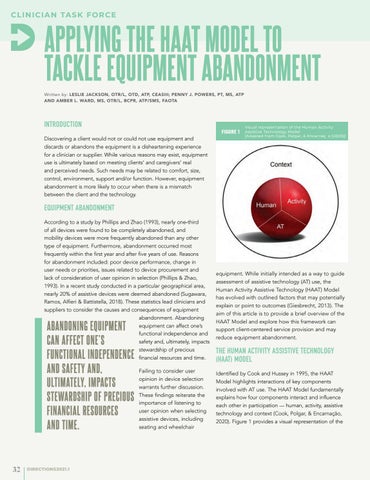CL I N IC IA N TA S K FOR C E
APPLYING THE HAAT MODEL TO TACKLE EQUIPMENT ABANDONMENT Written by: LESLIE JACKSON, OTR/L, OTD, ATP, CEASIII; PENNY J. POWERS, PT, MS, ATP AND AMBER L. WARD, MS, OTR/L, BCPR, ATP/SMS, FAOTA
INTRODUCTION
FIGURE 1
Discovering a client would not or could not use equipment and discards or abandons the equipment is a disheartening experience for a clinician or supplier. While various reasons may exist, equipment use is ultimately based on meeting clients’ and caregivers’ real and perceived needs. Such needs may be related to comfort, size, control, environment, support and/or function. However, equipment abandonment is more likely to occur when there is a mismatch between the client and the technology.
Visual representation of the Human Activity Assistive Technology Model [Adapted f rom Cook, Polgar, & Encarnaç o (2020)]
EQUIPMENT ABANDONMENT According to a study by Phillips and Zhao (1993), nearly one-third of all devices were found to be completely abandoned, and mobility devices were more frequently abandoned than any other type of equipment. Furthermore, abandonment occurred most frequently within the first year and after five years of use. Reasons for abandonment included: poor device performance, change in user needs or priorities, issues related to device procurement and lack of consideration of user opinion in selection (Phillips & Zhao, 1993). In a recent study conducted in a particular geographical area, nearly 20% of assistive devices were deemed abandoned (Sugawara, Ramos, Alfieri & Battistella, 2018). These statistics lead clinicians and suppliers to consider the causes and consequences of equipment abandonment. Abandoning equipment can affect one’s functional independence and safety and, ultimately, impacts stewardship of precious financial resources and time.
ABANDONING EQUIPMENT CAN AFFECT ONE’S FUNCTIONAL INDEPENDENCE AND SAFETY AND, ULTIMATELY, IMPACTS STEWARDSHIP OF PRECIOUS FINANCIAL RESOURCES AND TIME.
Failing to consider user opinion in device selection warrants further discussion. These findings reiterate the importance of listening to user opinion when selecting assistive devices, including seating and wheelchair
equipment. While initially intended as a way to guide assessment of assistive technology (AT) use, the Human Activity Assistive Technology (HAAT) Model has evolved with outlined factors that may potentially explain or point to outcomes (Giesbrecht, 2013). The aim of this article is to provide a brief overview of the HAAT Model and explore how this framework can support client-centered service provision and may reduce equipment abandonment.
THE HUMAN ACTIVITY ASSISTIVE TECHNOLOGY (HAAT) MODEL Identified by Cook and Hussey in 1995, the HAAT Model highlights interactions of key components involved with AT use. The HAAT Model fundamentally explains how four components interact and influence each other in participation — human, activity, assistive technology and context (Cook, Polgar, & Encarnação, 2020). Figure 1 provides a visual representation of the
CONTINUED ON PAGE
32
DIRECTIONS 2021.1
